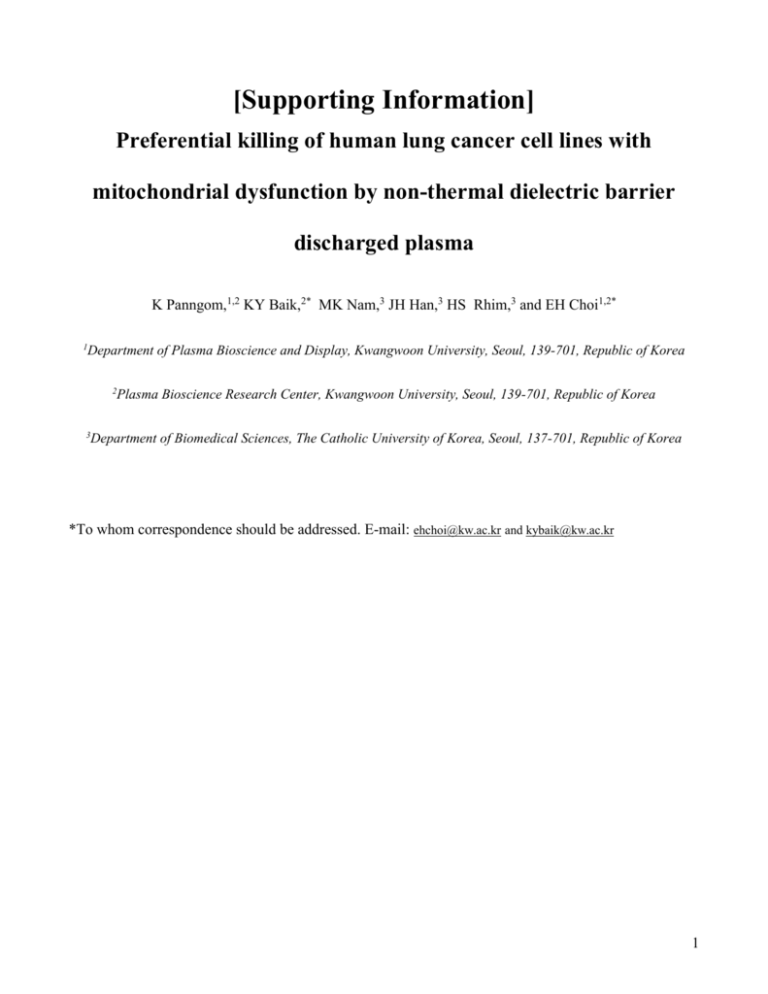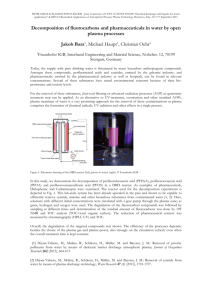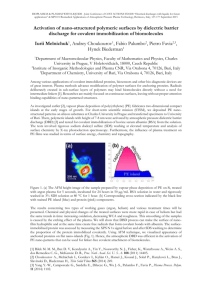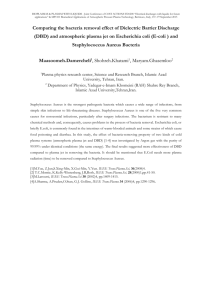Template for Electronic Submission to ACS Journals
advertisement

[Supporting Information] Preferential killing of human lung cancer cell lines with mitochondrial dysfunction by non-thermal dielectric barrier discharged plasma K Panngom,1,2 KY Baik,2* MK Nam,3 JH Han,3 HS Rhim,3 and EH Choi1,2* 1 Department of Plasma Bioscience and Display, Kwangwoon University, Seoul, 139-701, Republic of Korea 2 Plasma Bioscience Research Center, Kwangwoon University, Seoul, 139-701, Republic of Korea 3 Department of Biomedical Sciences, The Catholic University of Korea, Seoul, 137-701, Republic of Korea *To whom correspondence should be addressed. E-mail: ehchoi@kw.ac.kr and kybaik@kw.ac.kr 1 FigureS1. The survival rates of H460 and MRC5 after 24 hours from DBD plasma treatment on cells in suspension and adherent (seeded 1 day before) states. Cells were trypsinized and cell numbers were counted by hematocytometer (n=3). The relative cell numbers to control were plotted in the graph with standard deviation. Though suspension state was a little more stressful, plasma exposure in two states induced similar time-dependent death rate. 2 FigureS2. Cell cycle change of lung cells after 24 hours incubation from the non-thermal DBD plasma exposure. Cells were trypsinized, washed with 1x PBS, and fixed with cold 70% ethanol at 4 ºC for 1 hour. Cells were resuspended in 250 μl 1x PBS, and incubated at 37 ºC for 1 hour with addition of 5 μl of 10 mg/ml RNaseA. After adding 10 μl of 1 mg/ml propidium iodide (P4170, Sigma), cells were analyzed by flow cytometry (BD FACSVerseTM, BD Biosciences). The population of subG0 in lung cancer cell H460 was increased with plasma exposure time (red arrows), and more population was found in G2/M (blue arrows) after plasma exposure. In case of normal cell MRC5, it was hard to find big difference between control and DBD plasma treated cells. 1mM H2O2 is used for positive control. 3 (a) 4 (b) FigureS3. DBD plasma effects on cytoskeleton and morphology of (a) H460 and (b) MRC5. Cells were incubated for 24 hours from the exposure, fixed with 4% (v/v) paraformalaldehyde (15713, Electron Microscopy Sciences) for 15 minutes, permeabilized by 0.1% (v/v) triton x-100 (T8532, Sigma) for 20 minute, and stained by phalloidin dye (5 units/ml, Phallotoxins, Invitrogen) for 30 minute at room temperature. After mounting with glycerol, samples were observed by using fluorescence microscope (Ti-U, Nikon). Some cells failed to attach, become rounded, or attached with differentiated morphology. H460 has bumpy boundary with localized focal adhesion, and MRC5 attaches widely with losing their initial spindle shape. 5 FigureS4. DBD plasma effects on cell death of (a-d) H460 and (e-f) MRC5 lung cells at 1 day after plasma exposure. (a, e) The bright field images, (b, f) annexin V stained images, (c, g) propidium iodide (PI) stained images, and (d, h) merged images of two fluorescence images. Cells were trypsinized, washed with 0.5 ml of cold PBS, and suspended with 0.5 ml by cold 1x binding buffer. Then, 1.25 μl of Annexin V-FITC (0.5 μg/ml, Komabiotek) were added and incubated for 15 minutes at room temperature in the dark condition. Cells were washed and stained with 10 μl propidium iodide (PI) (0.3 μg/μl), and observed by fluorescent microscopy (Ti-U, Nikon). Both cell lines showed exposure timedependent dye staining ratio, but H460 were stained by PI even after 1 minutes’ plasma exposure. It is notable that MRC5 became bigger after 5 minutes’ exposure, while they became smaller by 1mM H2O2 treatment. 6 FigureS5. Mitochondrial ultrastructure changes after DBD plasma exposure. H460 and MRC5 were seeded on cover glass and incubated at 37 ᵒC for 3 hr after plasma exposure. They were fixed with Karnovsky’s fixative for 2 hr, fixed with osmium tetroxide for 30 minutes, and dehydrated by series of ethanol. Epon812 resin was used to embed cells and the polymerized block was detached from cover glass by using liquid nitrogen. The cell containing part was ultrathin sectioned and observed with transmission electron microscopy (JEM1010, JEOL). There happened significant damages on structure of mitochondria cristae in case of 5 minute’s plasma exposed H460, which may come from mitochondrial swelling. All the scale bars are 100 nm. 7








